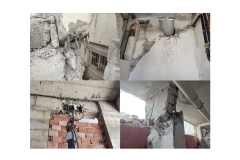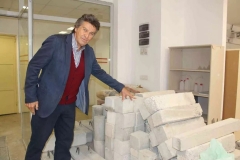
FACULTY OF ENGINEERING
Department of Civil Engineering
CIVE 206 | Course Introduction and Application Information
| Course Name |
Strength of Materials
|
|
Code
|
Semester
|
Theory
(hour/week) |
Application/Lab
(hour/week) |
Local Credits
|
ECTS
|
|
CIVE 206
|
Spring
|
2
|
2
|
3
|
6
|
| Prerequisites |
|
|||||||||
| Course Language |
English
|
|||||||||
| Course Type |
Required
|
|||||||||
| Course Level |
First Cycle
|
|||||||||
| Mode of Delivery | face to face | |||||||||
| Teaching Methods and Techniques of the Course | Problem SolvingLecture / Presentation | |||||||||
| Course Coordinator | ||||||||||
| Course Lecturer(s) | ||||||||||
| Assistant(s) | ||||||||||
| Course Objectives | The aim of this course is to provide the students with the basic knowledge of mechanics of deformable bodies. |
| Learning Outcomes |
The students who succeeded in this course;
|
| Course Description | In this course, the mechanics of deformable bodies and the stress that occurs due to the external loadings is defined. The calculation of stresses for different loading effects, the internal force diagrams of beams will be defined. The definition of axial loading, bending, shear, torsion, and combined loading effects is examined. |
|
|
Core Courses | |
| Major Area Courses |
X
|
|
| Supportive Courses | ||
| Media and Management Skills Courses | ||
| Transferable Skill Courses |
WEEKLY SUBJECTS AND RELATED PREPARATION STUDIES
| Week | Subjects | Related Preparation |
| 1 | Stress: Introduction, Equilibrium of a deformable body, Stress, Average normal stress in an axially loaded bar, Average shear stress, Allowable stress design, Design of simple connections | Chapter-1: 1.1-1.7 “Mechanics of Materials”, R. C. Hibbeler, 10th Ed., Pearson Global Editions, 2018 |
| 2 | Strain: Deformation, Strain | Chapter-2: 2.1-2.2 “Mechanics of Materials”, R. C. Hibbeler, 10th Ed., Pearson Global Editions, 2018 |
| 3 | Mechanical Properties of Materials: The tension and compression test, stress-strain diagram | Chapter-3: 3.1-3.2 “Mechanics of Materials”, R. C. Hibbeler, 10th Ed., Pearson Global Editions, 2018 |
| 4 | Mechanical Properties of Materials: Stress-strain behaviour of ductile and brittle materials, Strain energy, Poisson’s ratio, The shear stress–strain diagram, Failure of Materials | Chapter-3: 3.3-3.7 “Mechanics of Materials”, R. C. Hibbeler, 10th Ed., Pearson Global Editions, 2018 |
| 5 | Axial Load: Saint-Venant’s Principle, Elastic deformation of an axially loaded member, Principle of Superposition, Statically indeterminate axially loaded members, Thermal stress | Chapter-4: 4.1-4.6 “Mechanics of Materials”, R. C. Hibbeler, 10th Ed., Pearson Global Editions, 2018 |
| 6 | Torsion: Torsional deformation of a circular shaft, The torsion formula, Angle of twist, Statically indeterminate torque-loaded members | Chapter-5: 5.1; 5.2; 5.4; 5.5 “Mechanics of Materials”, R. C. Hibbeler, 10th Ed., Pearson Global Editions, 2018 |
| 7 | Midterm | |
| 8 | Bending: Shear and Moment diagrams, Graphical method for constructing shear and moment diagrams, Bending deformation of a straight member, The flexural formula, Unsymmetric Bending | Chapter-6: 6.1-6.5 “Mechanics of Materials”, R. C. Hibbeler, 10th Ed., Pearson Global Editions, 2018 |
| 9 | Bending: Shear and Moment diagrams, Graphical method for constructing shear and moment diagrams, Bending deformation of a straight member, The flexural formula, Unsymmetric Bending | Chapter-6: 6.1-6.5 “Mechanics of Materials”, R. C. Hibbeler, 10th Ed., Pearson Global Editions, 2018 |
| 10 | Transverse Shear: Shear in straight members, the shear formula, shear flow in built up members | Chapter-7: 7.1-7.3 “Mechanics of Materials”, R. C. Hibbeler, 10th Ed., Pearson Global Editions, 2018 |
| 11 | Combined Loadings | Chapter-8 “Mechanics of Materials”, R. C. Hibbeler, 10th Ed., Pearson Global Editions, 2018 |
| 12 | Stress and Strain Transformation | Chapter-9&10 “Mechanics of Materials”, R. C. Hibbeler, 10th Ed., Pearson Global Editions, 2018 |
| 13 | 2nd midterm exam | |
| 14 | Buckling of Columns | Chapter-13 “Mechanics of Materials”, R. C. Hibbeler, 10th Ed., Pearson Global Editions, 2018 |
| 15 | Semester Review | |
| 16 | Final |
| Course Notes/Textbooks | Hibbeler, R.C. (2018). “Mechanics of Materials”, Tenth Edition in SI Units, Pearson Global Editions. ISBN: 1292178205 |
| Suggested Readings/Materials | Beer F.P., Johnston E.R., DeWolf J.T., Mazurek D. (2015). “Mechanics of Materials”, Seventh Edition in SI Units, McGraw-Hill Education. ISBN : 9814595241. Ersoy U., Wasti S.T., Canbay, E. (2008). “Introductry mechanics of deformable bodies,” ODTÜ Yayınları, Ankara, ISBN: 9789755032313. |
EVALUATION SYSTEM
| Semester Activities | Number | Weigthing |
| Participation | ||
| Laboratory / Application | ||
| Field Work | ||
| Quizzes / Studio Critiques | ||
| Portfolio | ||
| Homework / Assignments | ||
| Presentation / Jury |
-
|
-
|
| Project | ||
| Seminar / Workshop | ||
| Oral Exams | ||
| Midterm |
2
|
60
|
| Final Exam |
1
|
40
|
| Total |
| Weighting of Semester Activities on the Final Grade |
2
|
60
|
| Weighting of End-of-Semester Activities on the Final Grade |
1
|
40
|
| Total |
ECTS / WORKLOAD TABLE
| Semester Activities | Number | Duration (Hours) | Workload |
|---|---|---|---|
| Theoretical Course Hours (Including exam week: 16 x total hours) |
16
|
3
|
48
|
| Laboratory / Application Hours (Including exam week: '.16.' x total hours) |
16
|
2
|
32
|
| Study Hours Out of Class |
14
|
3
|
42
|
| Field Work |
0
|
||
| Quizzes / Studio Critiques |
0
|
||
| Portfolio |
0
|
||
| Homework / Assignments |
0
|
||
| Presentation / Jury |
-
|
0
|
|
| Project |
0
|
||
| Seminar / Workshop |
0
|
||
| Oral Exam |
0
|
||
| Midterms |
2
|
18
|
36
|
| Final Exam |
1
|
22
|
22
|
| Total |
180
|
COURSE LEARNING OUTCOMES AND PROGRAM QUALIFICATIONS RELATIONSHIP
|
#
|
Program Competencies/Outcomes |
* Contribution Level
|
||||
|
1
|
2
|
3
|
4
|
5
|
||
| 1 | To have adequate knowledge in Mathematics, Science and Civil Engineering; to be able to use theoretical and applied information in these areas on complex engineering problems. |
|||||
| 2 | To be able to identify, define, formulate, and solve complex Civil Engineering problems; to be able to select and apply proper analysis and modeling methods for this purpose. |
X | ||||
| 3 | To be able to design a complex system, process, device or product under realistic constraints and conditions, in such a way as to meet the requirements; to be able to apply modern design methods for this purpose. |
X | ||||
| 4 | To be able to devise, select, and use modern techniques and tools needed for analysis and solution of complex problems in engineering applications. |
X | ||||
| 5 | To be able to design and conduct experiments, gather data, analyze and interpret results for investigating complex engineering problems or Civil Engineering research topics. |
|||||
| 6 | To be able to work efficiently in Civil Engineering disciplinary and multi-disciplinary teams; to be able to work individually. |
|||||
| 7 | To be able to communicate effectively in Turkish, both orally and in writing; to be able to author and comprehend written reports, to be able to prepare design and implementation reports, to present effectively, to be able to give and receive clear and comprehensible instructions. |
|||||
| 8 | To have knowledge about global and social impact of engineering practices on health, environment, and safety; to have knowledge about contemporary issues as they pertain to engineering; to be aware of the legal ramifications of engineering solutions. |
|||||
| 9 | To be aware of ethical behavior, professional and ethical responsibility; to have knowledge about standards utilized in engineering applications. |
|||||
| 10 | To have knowledge about industrial practices such as project management, risk management, and change management; to have awareness of entrepreneurship and innovation; to have knowledge about sustainable development. |
|||||
| 11 | To be able to collect data in the area of Civil Engineering, and to be able to communicate with colleagues in a foreign language; |
|||||
| 12 | To be able to speak a second foreign language at a medium level of fluency efficiently. |
|||||
| 13 | To recognize the need for lifelong learning; to be able to access information, to be able to stay current with developments in science and technology; to be able to relate the knowledge accumulated throughout the human history to Civil Engineering. |
|||||
*1 Lowest, 2 Low, 3 Average, 4 High, 5 Highest
NEWS |ALL NEWS

They examined building, showcased their models
Izmir University of Economics (IUE) Department of Civil Engineering and Architecture students examined 58 buildings in Izmir in terms of earthquake resistance

Photos of neglect
Asst. Prof. Dr. Egemen Sönmez, Lecturer at Department of Civil Engineering, Izmir University of Economics (IUE), went to the earthquake zone with

Exterior additions on buildings: cause for concern
Prof. Dr. Celalettin Kozanoğlu, Head of Department of Civil Engineering, Izmir University of Economics (IUE), warned about the water tanks placed on

We should take advantage of industrial building technology
Building tests and urban transformation works gained momentum throughout Turkey after the earthquake disaster, the epicenter of which was Kahramanmaraş and killed

Vital warnings in building inspections
After the earthquake disaster, the epicenter of which was Kahramanmaraş and which caused destruction in 10 cities, thousands of citizens rushed to

Negligence, not the soil, demolishes
Prof. Dr. Celalettin Kozanoğlu, Head of Department of Civil Engineering, Izmir University of Economics (IUE), stated that many buildings that were destroyed

‘Firewall’ project
IUE Rector Prof. Dr. Murat Aşkar and Head of Department of Civil Engineering, Prof. Dr. Celalettin Kozanoğlu developed the ‘firewall’ project, which

